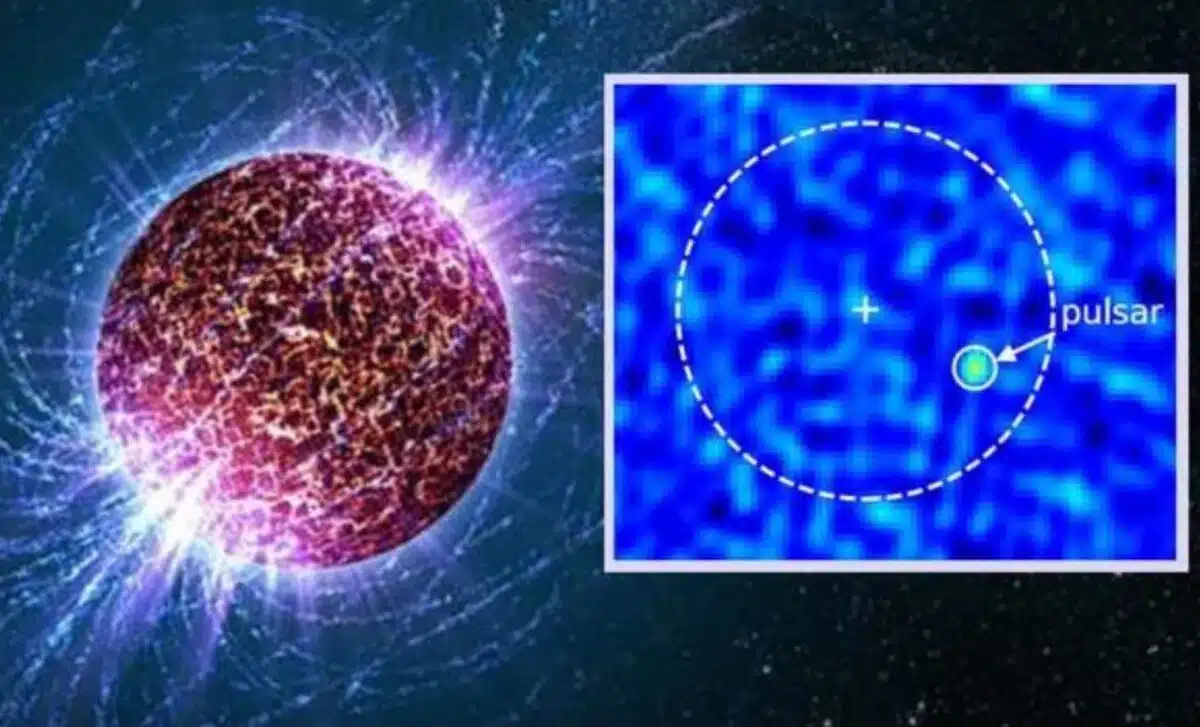
By Lydia Amazouz Published on July 5, 2024 11:00
Collected at: https://dailygalaxy.com/2024/07/us-navy-intern-rapidly-spinning-pulsar/
A rapidly spinning neutron star, known as a pulsar, has been discovered by an intern at the U.S. Naval Research Laboratory (NRL), Amaris McCarver, along with a team of astronomers.
This notable discovery was made within the dense star cluster Glimpse-CO1, located in the galactic plane of the Milky Way, about 10.7 light-years from Earth.
The Pulsar Discovery
The pulsar, designated GLIMPSE-C01A, was first observed by the Very Large Array (VLA) on February 27, 2021, but it remained hidden within a vast dataset until McCarver and her colleagues unearthed it in the summer of 2023. This pulsar is a millisecond pulsar, meaning it rotates hundreds of times per second.
Such extreme conditions make these neutron stars valuable for studying physics in environments unlike any other in the universe. Furthermore, their precise timing can be used as cosmic timepieces to measure gravitational waves, potentially leading to applications like a “celestial GPS” for space navigation.
“It was exciting so early in my career to see a speculative project work out so successfully,” McCarver, one of 16 interns in the Radio, Infrared, Optical Sensors Branch at NRL DC, said in a statement.
Neutron Stars and Their Significance
Neutron stars, including millisecond pulsars, are formed when stars with masses greater than eight times that of the sun exhaust their nuclear fuel and undergo supernova explosions. The core collapses, creating a dense neutron-rich core. This core is so dense that a tablespoon of it would weigh over a billion tons on Earth.
The rapid rotation of these neutron stars is a result of the conservation of angular momentum, similar to how an ice skater spins faster by pulling in their arms. Some neutron stars can spin as fast as 700 times per second.
In addition to their rapid rotation, neutron stars possess incredibly strong magnetic fields. These fields channel charged particles to the poles, creating jets of electromagnetic radiation. As these jets sweep across Earth, they appear as periodic pulses, giving pulsars their name.
The Importance of Combining Old Data and New Nechniques
This discovery highlights the importance of combining old data with new analytical techniques. McCarver and her team used data from the VLA’s Low-band Ionosphere and Transient Experiment (VLITE) and archival data from the Robert C. Byrd Green Bank Telescope (GBT). By reprocessing these data with modern algorithms, they confirmed the existence of GLIMPSE-C01A.

“This research highlights how we can use measures of radio brightness at different frequencies to find new pulsars efficiently, and that available sky surveys combined with the mountain of VLITE data mean those measurements are essentially always available,” Tracy E. Clarke, an astronomer with the NRL Remote Sensing Division, said in a statement. “This opens the door to a new era of searches for highly dispersed and highly accelerated pulsars.”
Scott Ransom, an NRAO scientist, emphasized the value of astronomical data archives, which allow researchers to make new discoveries from previously collected data. He noted, “Time and time again, new discoveries are being made from archival data. The value of these astronomical data archives couldn’t be more important.”
Implications for Future Research
The discovery of GLIMPSE-C01A opens the door to a new era of pulsar searches. The combination of VLITE and improved algorithms allows astronomers to revisit previous data and uncover new pulsars that were previously undetectable. This approach is particularly valuable for finding the most exotic pulsars, such as those in the deepest parts of the galactic plane or in tight binary systems.
Emil Polisensky, an NRL astronomer, noted that millisecond pulsars could provide a method for autonomously navigating spacecraft from low Earth orbit to interstellar space, independent of ground-based GPS. “The confirmation of a new millisecond pulsar identified by Amaris highlights the exciting potential for discovery with NRL’s VLITE data and the key role student interns play in cutting-edge research,” Polisensky said.
By combining old data with new analytical techniques, the discovery of the rapidly spinning pulsar GLIMPSE-C01A not only enhances our understanding of neutron stars and their extreme conditions but also showcases the potential for future discoveries using archival data. As technology and analytical methods continue to improve, we can expect even more groundbreaking findings in the field of astrophysics.

Leave a Reply